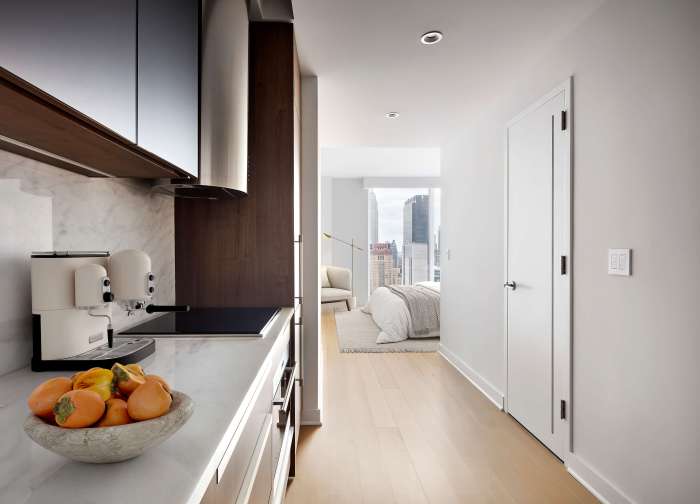BY LINCOLN ANDERSON | A judge who temporarily blocked the 14th St. busway from going forward a month ago, on Tuesday gave the embattled scheme the green light.
State Supreme Court Justice Eileen Rakower ruled that the city can put its novel Transit and Truck Priority lanes plan into effect. In doing so, she found against a community lawsuit by a broad coalition of Village and Chelsea block associations and large residential co-op buildings.
Under the city’s plan — now set to go into effect Monday — only buses and trucks with at least three axles will be allowed to use 14th St. as a through street between Third and Ninth Aves. daily from 5 a.m. to 10 p.m.

Delivery vehicles and residents will be able to drive onto the street for drop-offs or pickups, but have to take the next available right turn. Residents will also be able to drive onto the street for parking. The first of its kind in New York City, the traffic plan is being called an 18-month “pilot project.”
Many opponents fear the 14th St. car ban will push displaced traffic onto their nearby side streets. Meanwhile, 14th St. residents are concerned about maintaining curbside building access. But the city says the scheme will speed up buses during the hours it’s needed the most.
Select Bus Service — along with a reduction in the number of bus stops — went into effect on the M14 route a month ago in another effort to get the buses moving faster.
Tim Minton, a spokesperson for the Metropolitan Transportation Authority, assured that speed and efficiency would be increased.
“This ruling is a win for 27,000 daily bus riders who can get to work and where they need to go faster,” he said. “Speedier rides mean more reliability, better service and added convenience. We thank the New York City Department of Transportation for its dedication to implementing a more efficient design on 14th St.”
A D.O.T. spokesperson added, “Today’s ruling allows us to move ahead to improve bus service along the corridor. We are beginning work immediately and Transit and Truck Priority will go into effect Mon., Aug. 12.”
Mayor Bill de Blasio tweeted his excitement at the plan’s court win:
“JUST IN: We prevailed in our legal fight to speed up buses on 14th Street! With this hurdle clear, @NYC_DOT is moving ahead with final roadwork so we can get New Yorkers moving on one of the city’s busiest thoroughfares. Let’s get this DONE!”
The plaintiffs were represented by activist attorney Arthur Schwartz, the Village’s male Democratic district leader, who did the case pro bono. Schwartz, who lives on W. 12th St., was also an individual plaintiff in the suit.
Schwartz, in a group e-mail to the opponents, wrote: “We think the judge made three errors. The first is that she allowed D.O.T. to assert that they took sufficient consideration of environmental factors, without any proof. Second, she did not make them explain why they need the restrictions to stretch from 5 a.m. to 10 p.m., when the bus speed problems D.O.T. described were only between 8 a.m. and 10 a.m., and 5 p.m. and 7 p.m. Third, she did not consider at all how unsafe the 12th and 13th St. bike lanes are; they are an invitation to bicyclist injury.”
Crosstown bike lanes were added on the two streets, anticipating a full L-train shutdown, which never materialized — but D.O.T. made them permanent anyway.
“Over all,” Schwartz continued, “I am horrified that my block, 12th St., will now have 350 cars an hour going down it (D.O.T. numbers); that’s one car every 10 seconds on a residential street.
“I am also disappointed in the elected officials, particularly Mayor de Blasio, who wants to be president (!), and Corey Johnson, who wants to be mayor, because of their utter lack of consideration or concern about the people living in the affected communities. Not a great qualification for higher office.”
Speaking after the ruling, Schwartz said that Eric Beaton, D.O.T. deputy commissioner for transportation planning and management, submitted a letter arguing that traffic lights could be controlled to ensure that the traffic would flow smoothly, somehow avoiding vibrations that could harm fragile historic Village and Chelsea buildings. Schwartz said the judge deemed this the “hard look” she had asked the city agencies to do last month.
Schwartz added that traffic data and times were only presented for morning and evening rush hours — so the argument wasn’t made why the no-cars plan should exist at other times.
“It may be one of the reasons we appeal,” he noted.
The attorney also bristled at transit advocates and cyclists who criticize the opponents as wealthy.
“Most of the people in the block associations are not rich at all,” he said. “They tend to be an older group. They are in rent-regulated apartments.”
Schwartz predicted the T.T.P. plan won’t start until Labor Day since “they haven’t finished painting the bus lane.” However, again, D.O.T. says it will start Aug. 12.
The attorney also scoffed at the city’s claim that the situation on 14th St. with slow buses and traffic is an “emergency” since the M.T.A., in 2011, listed the street as one slated to get S.B.S. Yet, there clearly was no rush, as S.B.S. wasn’t implemented until last month — eight years later.
After all the hoopla, ultimately, the plan would only result in the crosstown buses running a couple of minutes faster, the attorney charged.
“The goal is to make the buses go 2.1 minutes faster in the morning — 2.1 eastbound, 2.9 minutes westbound, something like that,” he said. “It was in Beaton’s affidavit.”

















